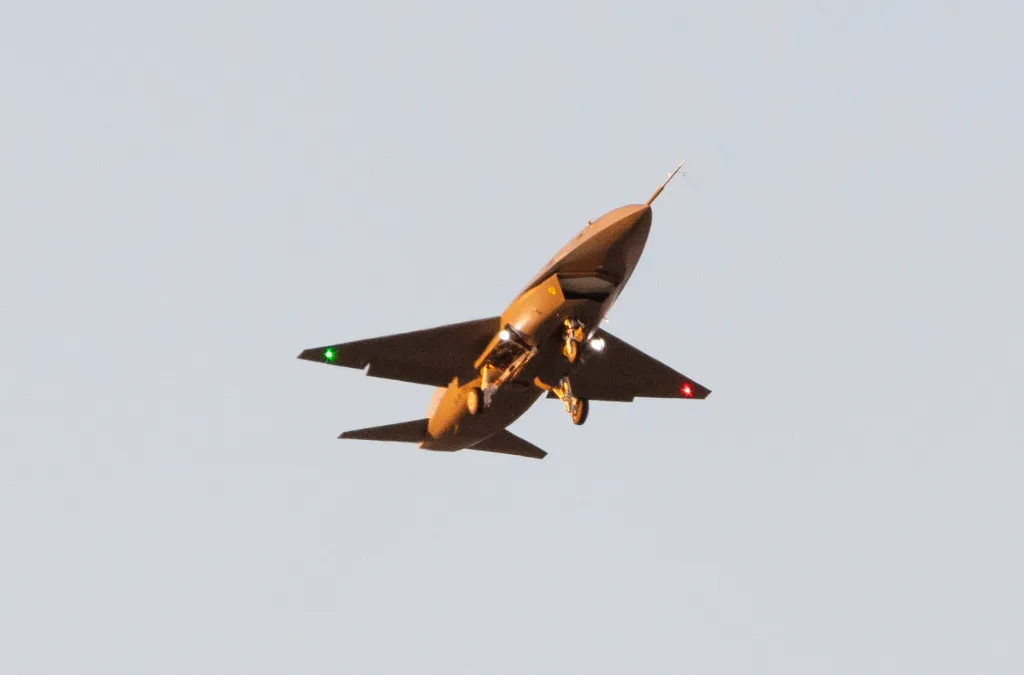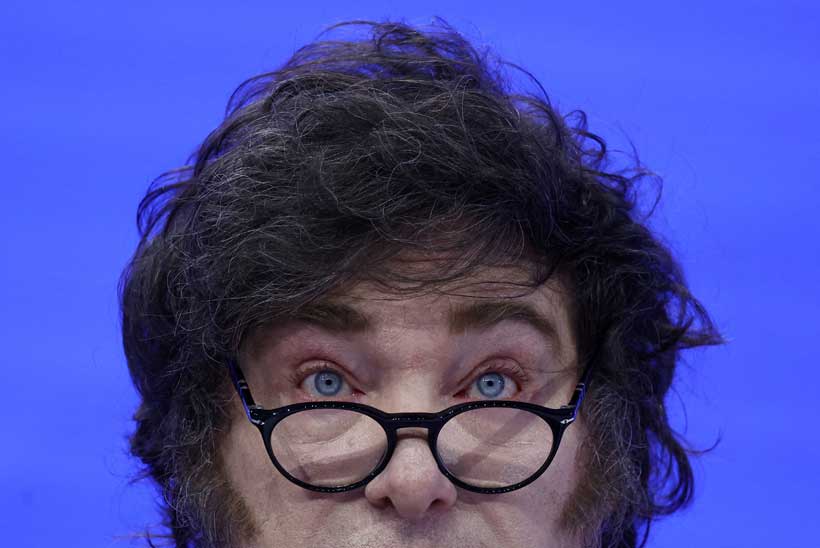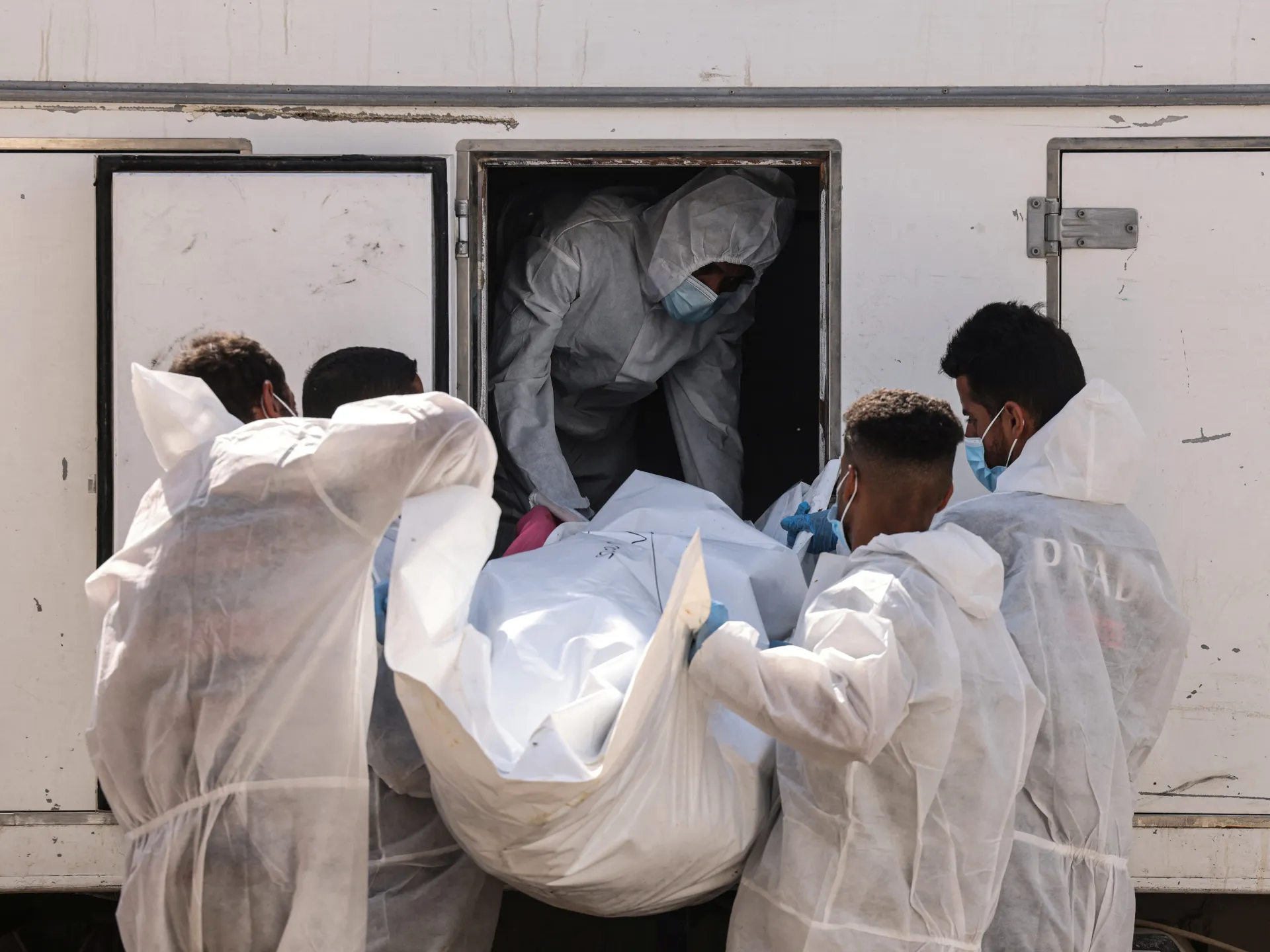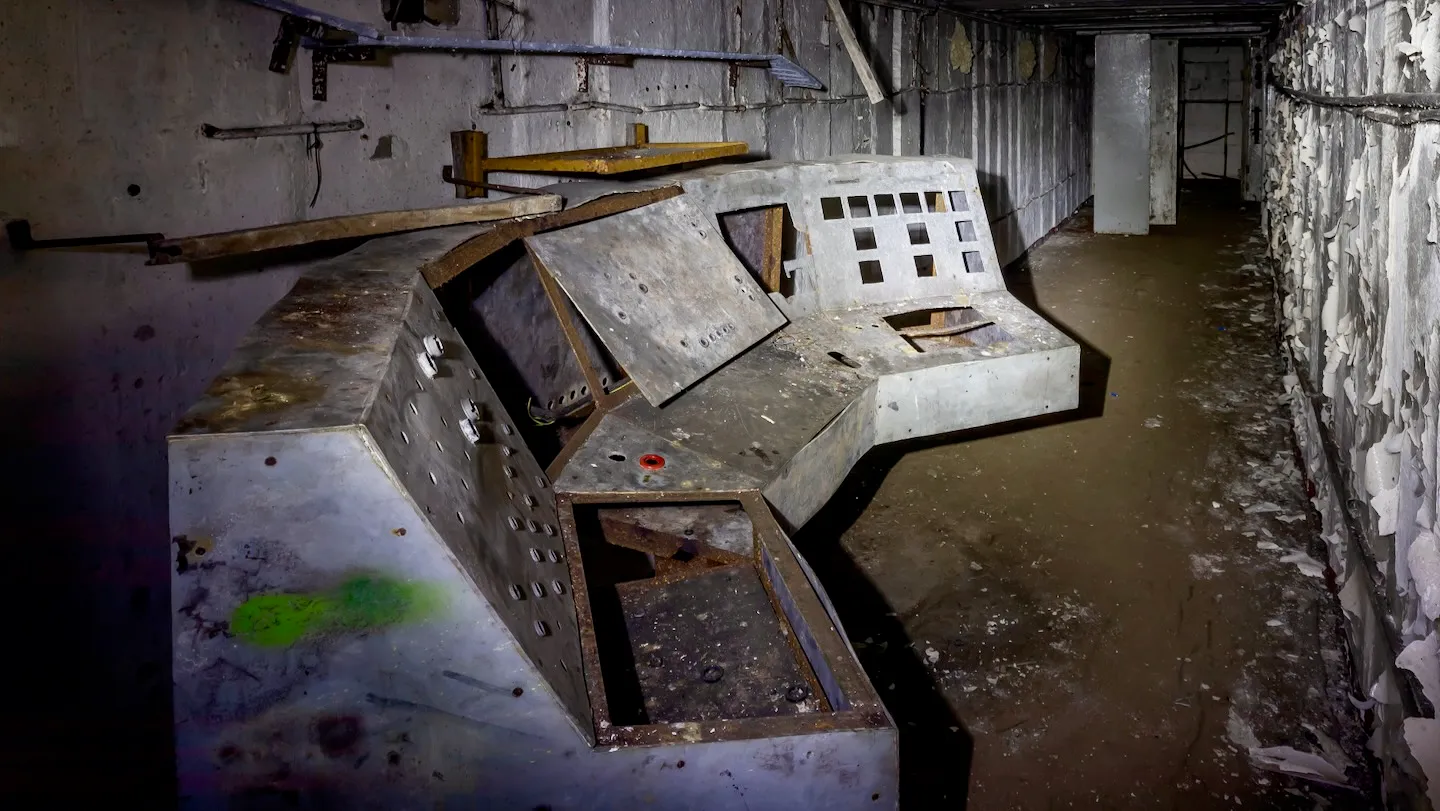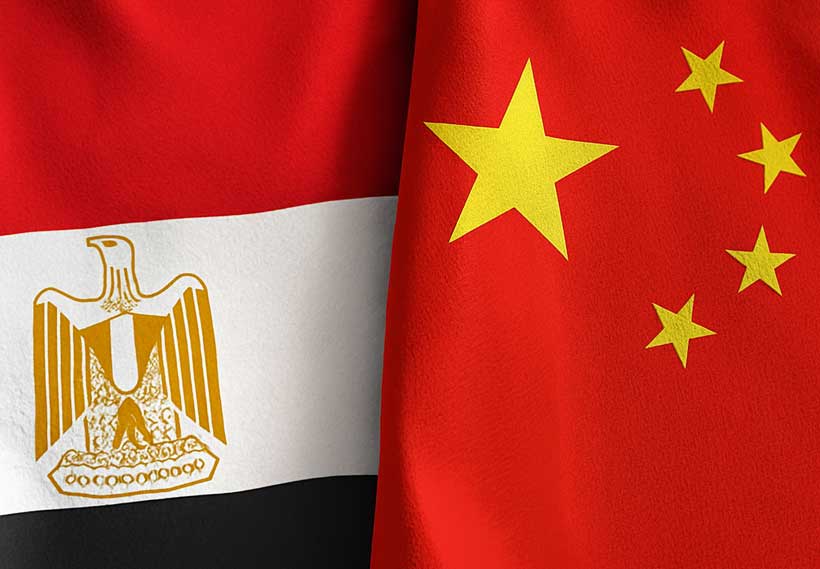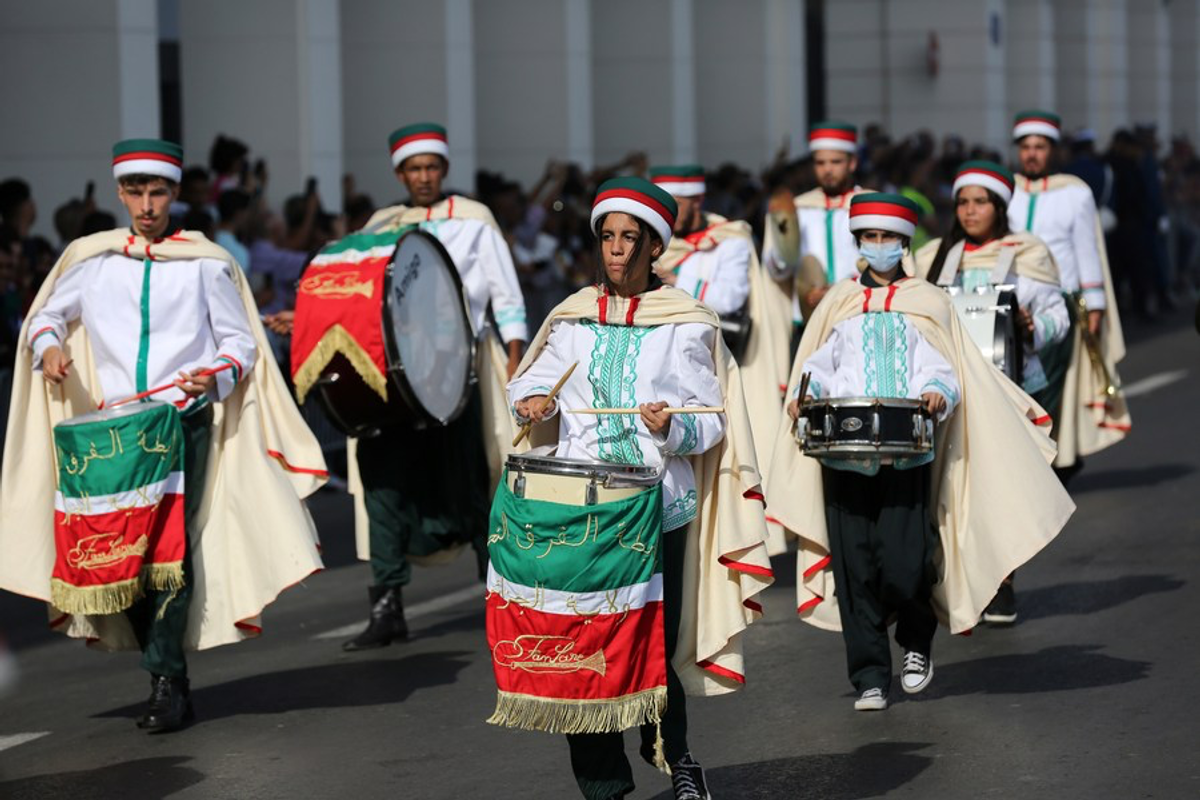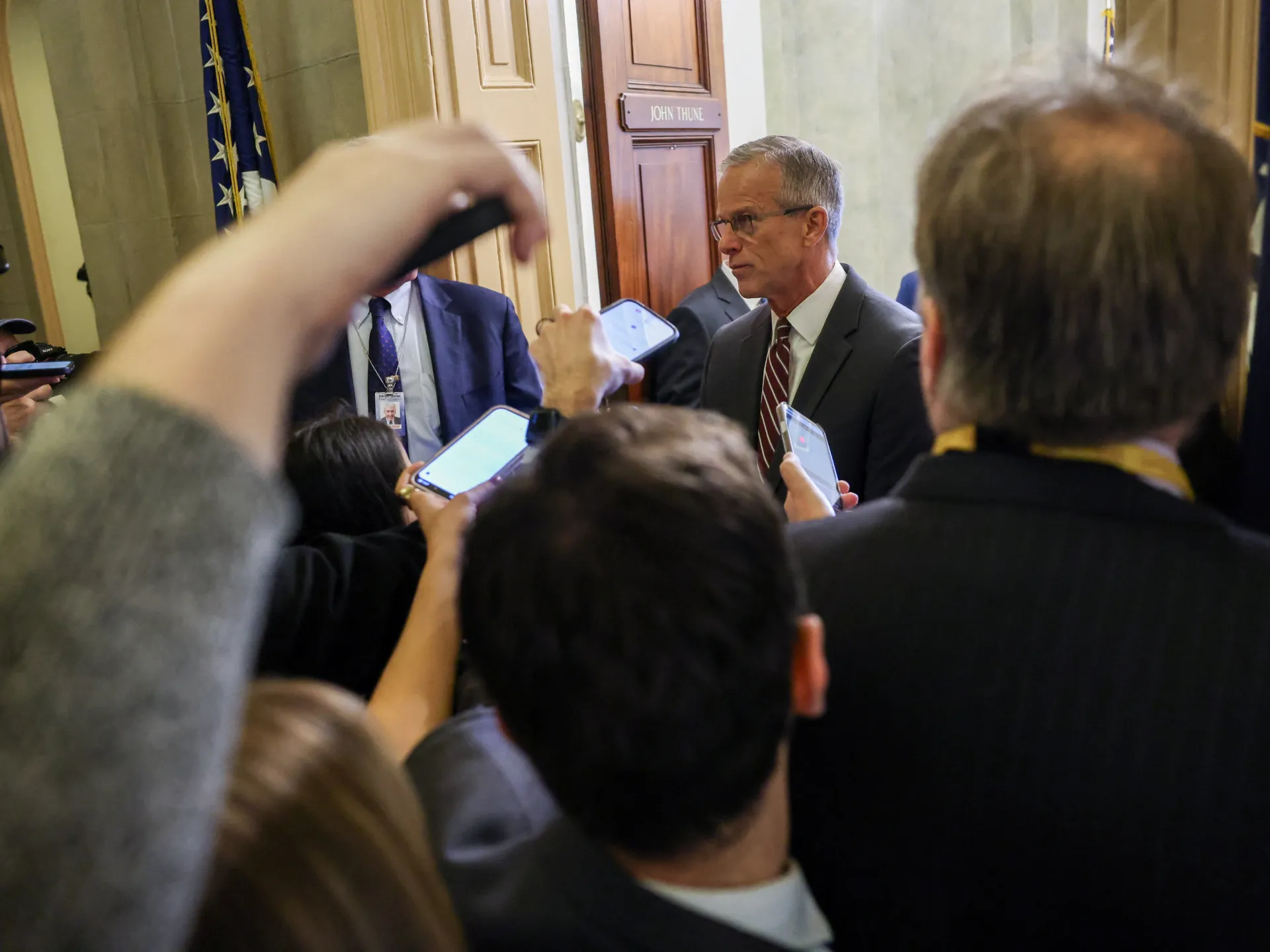Anduril’s YFQ-44 Fury ‘Fighter’ Drone Has Flown (Updated)
Anduril’s YFQ-44A ‘fighter drone’ prototype has now made its maiden flight. The YFQ-44A is one of two designs currently being developed under the first phase, or Increment 1, of the U.S. Air Force’s Collaborative Combat Aircraft (CCA) program. The other is General Atomics’ YFQ-42A, which took to the skies for the first time earlier this year.
A TWZ reader has shared pictures with us of the YFQ-44A in flight, which were taken earlier today at Southern California Logistics Airport in Victorville, California. The drone was also seen accompanied by two L-29 Delfin trainer jets acting as chase planes. We have reached out to Anduril for more information.





Additional imagery of the YFQ-44A in flight is now beginning to circulate online.
Last year, the Air Force announced that it trimmed back the field of prospective Increment 1 CCA designs to the proposals from Anduril and General Atomics. However, Fury’s story traces back to the late 2010s and an aggressor drone concept from a company called Blue Force Technologies, which Anduril acquired in 2023, as you can read about in extensive detail in this past War Zone feature.
“This marks another major milestone for the CCA program, now with two new uncrewed fighter aircraft going from concept to flight in less than 2 years,” the Air Force has now said in a press release confirming the YFQ-44A’s first flight. “This flight testing expands the program’s knowledge base on flight performance, autonomous behaviors, and mission system integration. By advancing multiple designs in parallel, the Air Force is gaining broader insights and refining how uncrewed aircraft will complement crewed fifth-and sixth-generation platforms in future mission environments.”

“This milestone demonstrates how competition drives innovation and accelerates delivery,” Secretary of the Air Force Troy Meink said in a statement. “These flights are giving us the hard data we need to shape requirements, reduce risk, and ensure the CCA program delivers combat capability on a pace and scale that keeps us ahead of the threat.”
Anduril and the Air Force had previously declined to provide a hard timeline for when the YFQ-44A would make its first flight.
“We have multiple vehicles at our test facility in ground testing right now, and we’re in the final stages before first flight,” Diem Salmon, Anduril’s Vice President of Air Dominance and Strike, had told TWZ and others at the Air & Space Forces Association’s 2025 Air, Space, and Cyber Conference back in September. “All in all, we’re still well ahead of the program schedule in terms of getting YFQ-44A into the air. [We] feel really confident in our ability to do so and still feel really good about the program schedule.”
At that time, Salmon, as well as Jason Levin, Anduril’s Senior Vice President of Engineering for Air Dominance and Strike, offered additional details about the plans for Fury’s first flight, including the level of autonomy the company was hoping to demonstrate, which was a key schedule driver. You can read more about that here.
“It was not a race to get to first flight as fast as humanly possible. It was, how do we field this really advanced and novel capability as fast as we can,” Salmon had said. “And with that comes the recognition that the autonomy is the hard part here, and so that’s the thing that you actually need to burn down from a technical development, testing, and risk perspective. And so that’s how we’ve approached our program.”

Secretary of the Air Force Meink had also told TWZ and others at a separate roundtable at the Air, Space, and Cyber Conference that his service was hoping to see the YFQ-44A fly by the middle of October. In a keynote address at the event, now-retired Air Force Chief of Staff Gen. David Allvin described Fury’s first flight as “imminent,” as well.
“My engineers tell me that if we push the button … [the drone] will take off, it’ll fly around, and it’ll come back home,” Anduril founder Palmer Luckey had also told reporters earlier this month, according to Breaking Defense. “The Air Force is going through a process of evaluation that is very, very reasonable, I think.”
“Obviously, now the problem is we’re into the shutdown,” Luckey added at that time. “Certainly … a lot of stuff stops moving.”
The U.S. federal government remains in a shutdown. Efforts have been made to find continued funding for various priority efforts, especially within the U.S. military.
With the YFQ-42A and the YFQ-44A now flying, “developmental flight activities continue across both vendor and government test locations, including Edwards Air Force Base [AFB], where envelope expansion and integration work will inform future experimentation,” according to the Air Force’s press release today. “The Air Force’s Experimental Operations Unit (EOU), located at Nellis AFB, will be instrumental in evaluating operational concepts as the program transitions from testing to fielding substantial operational capability for Increment 1 before the end of the decade.”

How many Increment 1 CCAs the Air Force ultimately plans to acquire is not entirely clear. Air Force officials have said previously that between 100 and 150 drones could be ordered under the program’s first phase. It also remains to be seen whether the service buys YFQ-42As, YFQ-44As, or a mix of both.
“CCA is part of the Next Generation Air Dominance Family of Systems and leverages the Department’s Government Reference Architectures—enabling platform-agnostic autonomy development, streamlined integration across vendor systems, and more agile capability updates over time,” the Air Force’s release also noted. “The architecture is built to integrate with Allied and Joint partners, offering common autonomy and mission system standards that support seamless interoperability and teaming across Services and coalition forces.”

There are still plans for at least one more incremental CCA developmental cycle, the requirements for which have yet to be publicly disclosed. However, the submissions for Increment 2 are already expected to be significantly different from the ones for Increment 1. in September, Lockheed Martin unveiled a new CCA-type drone, called Vectis, which the company suggested could be proposed for Increment 2. This week, Aviation Week also disclosed the existence of a new drone design from Northrop Grumman subsidiary Scaled Composites, currently referred to just as Project Lotus, which that outlet described in terms of its similarities to Vectis.
Increment 2 has also long been expected to involve foreign participation. Earlier this month, authorities in the Netherlands notably announced they had signed the letter of intent about joining the CCA program.
The Air Force’s CCA effort is also directly intertwined with similar efforts underway within the U.S. Marine Corps and the U.S. Navy. The Air Force still has many general questions to answer about how its future CCA fleets, whatever they are comprised of, will be deployed, launched, recovered, supported, and otherwise operated, not to mention employed tactically.
As such, in addition to being an important milestone in Fury’s development, the YFQ-44A’s first flight is also another step forward for the Air Force’s larger CCA plans.
Update, 3:45 PM EST:
Anduril has now put out its own release regarding the YFQ-44A’s first flight.
“Flight testing is where we prove to ourselves, to the Air Force, to our allies, and to our adversaries that these proclamations about game-changing technology go beyond words. They’re real, and they are taking to the skies today,” Jason Levin, Senior Vice President of Engineering for Air Dominance and Strike at Anduril, writes. “The flight testing process is where we prove that our aircraft meets the mark in terms of speed, maneuverability, autonomy, stealth, range, weapons systems integration, and more. As YFQ-44A climbs higher, we’re proving that it doesn’t merely look like a fighter, but that it performs like one.”
“Flight testing for the CCA program is also about more than simply proving raw fighter performance in a vacuum. The real step change that autonomy is driving is enabling a team of robotic aircraft to collaborate to accomplish mission objectives,” he adds. We designed YFQ-44A for a specific Air Force mission: to enhance survivability, lethality, and mission effectiveness by teaming with crewed fighter aircraft or operating independently. Through flight testing, Anduril and the Air Force are developing those collaborative, manned-unmanned teaming concepts and tactics that will inform how we integrate, fight with, and sustain truly autonomous aircraft.”

Levin also speaks more directly to Anduril’s previously stated focus on autonomy for the first flight, and now for testing going forward.
“YFQ-44A was not designed to be a remotely-piloted aircraft, and that is not how we are operating it — from first flight and forever onward. All of our taxi and flight tests have been and will continue to be semi-autonomous. This is a new age of air power; there is no operator with a stick and throttle flying the aircraft behind the scenes,” he says in the release. “Our aircraft is ushering in this new paradigm with incredible technical precision: it executes a mission plan on its own, manages flight control and throttle adjustment independent of human command, and returns to land at the push of a button, all under the watchful eye of an operator “on the loop” but not in it.”
“It must do more than just fly. CCA are built to win the high end fight; that’s what we’ve built the software that powers YFQ-44A to do. In the air, the fully integrated weapon system processes data at the speed that combat demands. It identifies targets and commands effects, enhancing the lethality, survivability, and effectiveness of the combined team,” he continues. “On the ground, YFQ-44A’s software backbone tracks and manages maintenance, vehicle health, and more, streamlining sustainment to ensure that it’s always ready to fly. In short, YFQ-44A’s autonomy is what makes it more than just a flying machine, but one that’s ready to fight.”
Anduril’s release also includes details about the production plans for the YFQ-44A, which tie into a “hyperscale” production facility, called Arsenal-1, that the company is now building in Ohio.

“To achieve the scale we need at the speed that the threat demands, we are building and testing a new type of production system for YFQ-44A. Through the employment of a common software backbone called ArsenalOS, our production system multiplies the effects of the thousands of design-for-manufacturing decisions made during the development of YFQ-44A,” according to Levin. “That system is underpinned by a manufacturing philosophy focused on simple, mature, and low-risk production technologies, rather than relying on manufacturing miracles. YFQ-44A will be produced at rate by a broad labor pool, commoditized supply chain, and industry-standard manufacturing processes.”
“YFQ-44A is streaking through the skies, but its next chapter will be written on the factory floors of America’s heartland. Our investment in this aircraft is the driving force behind Arsenal-1, the 5 million square foot production facility that we’re building in Columbus, Ohio,” he adds. “YFQ-44A will be the first program to move into the factory when its doors open, and we are on track to begin production of prototype CCA at Arsenal-1 in the first half of 2026.”
“We’re not waiting for Arsenal-1 to start building, though. In the meantime, we have already more than doubled our manufacturing speed for YFQ-44A by rapidly optimizing our processes and workflows, and by making hundreds of tweaks to the design of the aircraft to further enhance producibility,” Levin also notes. “Making it this far has required herculean investments from the combined Anduril-USAF team measured in time and money.”
Update, 6:00 PM EST:
During a press call today, Anduril’s Jason Levin provided TWZ and other outlets with additional information about today’s first flight and future testing plans. The company has so far declined to say how long the YFQ-44A’s first flight lasted or provide other, more specific details about what it entailed.
“I don’t think I can say any specifics, but the team is very excited,” Levin said in response to a question about whether the first flight went as planned. He did say that the YFQ-44A flew today with an Anduril flight autonomy mission package, but declined to speak to what additional mission autonomy capabilities might be integrated into the drone in future test flights.
“I think it’s kind of the standard buildup that you would have in in in aviation. So I think it’s just checking out subsystems, continue to burn down risk, continue to prove that systems are flight worthy and things are working as expected, matching up the simulation, and then just to continue to start to push the envelope,” he added when asked about potential hurdles to further expanding Fury’s flight envelope. “So, I don’t see any specific risk. We’ve kind of designed Fury to be a simple, low-risk, producible system on purpose, so that we didn’t have to clear any huge hurdles while progressing through the flight test program.”
“We still have a lot to do. So, we’ve shown the airplane works. We’ve shown the autonomy works. The software brain that powers it works. We have a lot to do in terms of proving out the speed, maneuverability, autonomy, stealth, weapon systems integration, and more. And that’s when we’re going to start developing the tactics with experimentation with the Air Force,” he also said. “We’ve already begun integrating weapons with YFQ-44A, and we’ll execute our first live shot next year. And then over the next year, we’ll execute multi-ship mission autonomy, deploy weapons from YFQ-44A, fly in conjunction with crewed fighters, and operate outside of test locations.”
“I can’t talk to the specific build-up to firing a missile, but you can kind of imagine it’s not going to be too dissimilar from any aircraft doing a first shot. So we’re just going to build up in terms of flying, integrating systems, and testing them out,” he added when asked to elaborate on the weapon testing plans. “We have a test planning collaboration with the Air Force for things like that.”
He offered a similar response when asked about the plans for multi-ship flight testing, which is set to be conducted in coordination with crewed fighters.
“We have a flight test kind of procedure that I think is going to move quite rapidly, because we’ve built out a lot of the autonomy, so we can start hitting the other test points and showing the capability of the aircraft much quicker,” Levin said, speaking more generally. “And so we feel confident that’ll get us pretty quickly into the live shot, multi-ship autonomous flight, and then autonomous flight with crewed aircraft.”
“We’ve [got] currently multiple Fury fully-built aircraft in testing, as well as multiple aircraft in various stages of the manufacturing process,” he also noted. Anduril had previously disclosed this at the Air & Space Forces Association’s 2025 Air, Space, and Cyber Conference in September.
“Arsenal-1, it is going to open next year, and it can support the increment one demand that the U.S. Air Force has for CCA,” he added. “And so we’re scaling up that facility to build hundreds of aircraft.”
Contact the author: [email protected]
